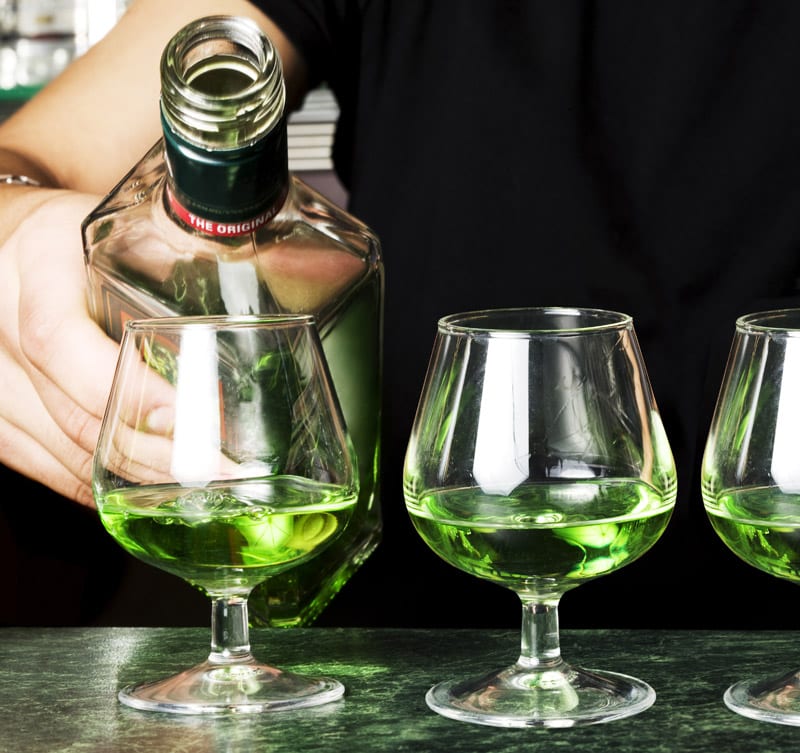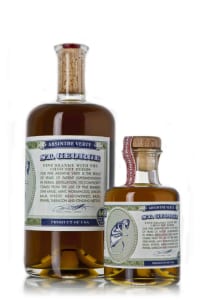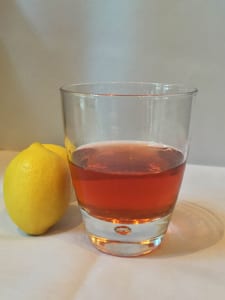Why the literary liquor deserves a second chance.

Ten years ago, while studying abroad in Italy, I drank absinthe for the first time. Excited to try the infamous drink consumed by so many literary greats, my enthusiasm faded after the first sip. This mysterious green liquor smacked of licorice and wasn’t given the traditional softening of water and sugar: it was like a punch in the mouth. My friends and I quickly dismissed all absinthes as bad and reverted back to the safety of wine and beer. A decade later and absinthe has found its way onto cocktail lists across Atlanta (including Buckhead restaurants, such as Bourbon Bar, Prohibition, and Holeman and Finch Public House) as a key ingredient in craft cocktails and a fine liquor enjoyed on its own. My curiosity was piqued.
Absinthe, like vodka, is a neutral grain spirit that is altered with various flavoring agents, the way gin is flavored with juniper berries. When it’s created in the classic method, producers macerate the absinthe with wormwood, green anise, hyssop and other herbs and botanicals. Next, it is redistilled and re-macerated with wormwood for the color and the aroma. Stuck on my perceptions that wormwood was toxic and that absinthe had been illegal (right?), I sought out some answers from an expert.
H&F Bottle Shop assistant manager Amber Aristy was quick to set the story straight. “For a long time absinthe was outlawed in the U.S. (until 2007) and most of Europe due to misconceptions about thujone, the chemical component in wormwood that can cause convulsions and possible death,” Aristy says. “Thujone occurs naturally in wormwood in extremely low dosages, as well as in sage, oregano and several types of mint. A person would die from alcohol poisoning long before thujone would have had the chance to act.”
But what about Oscar Wilde’s hallucinatory “green fairy”? Aristy explains, “To keep its color—absinthe’s green color comes from chlorophyll— absinthe must be bottled to at least 60 percent ABV [alcohol by volume]— that’s 120 proof. Classic absinthes were bottled as high as 68 percent ABV or 136 proof! That is enough to make anyone act a little nutty.”

Today’s absinthes have to meet much stricter production regulations than those bottled in Wilde’s day, and there are far fewer to choose from, but Atlanta-area restaurants and bottle shops offer up a respectable range of choices spanning Europe as well as a few states in the U.S. (even Kentucky!).
Convinced that my first taste hadn’t given absinthe a fair chance, I tried the Swiss La Clandestine Blanche absinthe from Kimball House’s 13- bottle absinthe service menu. Instead of overpowering licorice, I discovered a soft olive drink that was slightly buttery and subtly licorice-flavored (“like a jelly bean,” my husband commented).
If you’re looking to drink absinthe in the traditional manner (as it’s served at Kimball House), the mixologist will pour the chilled liquor into a cocktail glass, then will slowly drip cold water over a sugar cube and filter it with an absinthe spoon to dilute the drink (you can choose to have it served over chipped ice).
For a subtler foray into the world of absinthe, consider ordering a cocktail featuring absinthe, like the Sazerac from Bourbon Bar.
True, if you hate black licorice, this isn’t the drink for you. Everyone else? Go ahead and give it another go.
BUYING TIP:
“Look for an absinthe that has been made by the distillation method as opposed to ‘cold compounding.’ You’ll get a more nuanced, balanced spirit that is easier to enjoy.” Amber Aristy H&F Bottle Shop assistant manager
PAIRING TIP:
Try absinthe with Brie or Gorgonzola cheese with crackers or for dessert with rich chocolate.
 BOURBON BAR SAZERAC
BOURBON BAR SAZERAC
2 ounces
Few Rye Whiskey
1/4 ounce brown
sugar syrup
5 dashes Peychaud’s
Bitters
1 dash Angostura Bitters
1 spritz St. George
Absinthe Verte
lemon peel for garnish
Add all ingredients into a mixing glass over ice and stir until all components are thoroughly combined and glass is very cold to the touch. Spritz absinthe into chilled rocks glass, strain cocktail into glass with no ice, express lemon peel over the cocktail and discard.
“At Bourbon Bar, we spritz St. George Absinthe Verte in a rocks glass as a garnish for our house Sazerac. This particular absinthe has great spicy notes as well as enormous citrus flavors.” Michael Magnole GM at Bourbon Bar
STORY: Kelly Skinner
Simply Buckhead is an upscale lifestyle magazine focused on the best and brightest individuals, businesses and events in Buckhead, Brookhaven, Sandy Springs, Dunwoody and Chamblee. With a commitment to journalistic excellence, the magazine serves as the authority on who to know, what to do and where to go in the community, and its surroundings.













